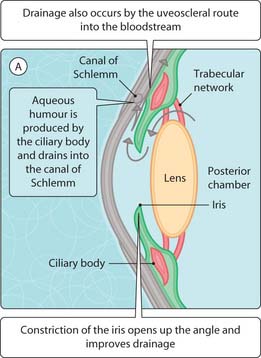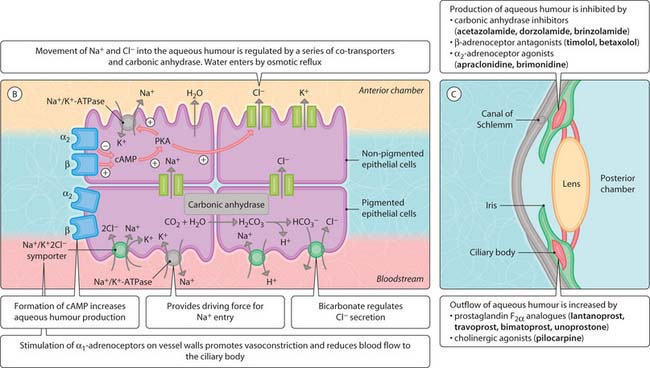32 The eye
Pupil size is controlled by light and the activity of the parasympathetic and sympathetic nervous systems. The release of acetylcholine from parasympathetic nerves contracts the circular smooth muscle of the iris, resulting in pupil constriction (miosis). In contrast, norepinephrine released from sympathetic nerves innervating radial smooth muscle stimulates pupil dilatation. Contraction of ciliary smooth muscle initiated by acetylcholine relieves tension in suspensory ligaments and the lens adopts a spherical shape. This allows the lens to accommodate for near vision. Contraction of ciliary smooth muscle also promotes drainage of aqueous humour through the trabecular network and via the canal of Schlemm (Fig. 3.32.1). Occlusion of the outflow channels impaires and outflow of aqueous humour from the anterior chamber increases intraocular pressure (glaucoma). This increase can lead to degeneration of the retinal ganglion cells, visual impairment and blindness. Primary open-angle glaucoma is the most common form and is associated with structural changes to the trabecular network leading to increased resistance to drainage of aqueous humour, which can be treated pharmacologically. Acute-angle closure is a sudden obstruction of the angle of the anterior chamber by the iris and may occur in structurally predisposed eyes, in which the angle of the anterior chamber is narrow, or as a result of a mature cataract, dilatation of the eye (in dim light), stimulation of the sympathetic nervous system or anticholinergic drugs. Treatment to reduce intraocular pressure involves peripheral laser iridectomy or surgical iridectomy.


Fig. 3.32.1 The eye and aqueous humour. (A) Drainage; (B) formation of aqueous humour; (C) drugs used in glaucoma.
< div class='tao-gold-member'>
Stay updated, free articles. Join our Telegram channel

Full access? Get Clinical Tree




